The Prestige Factor
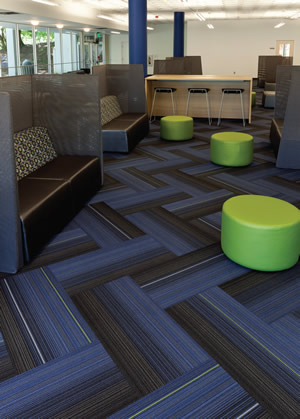
PHOTO © J&J FLOORING
Carpet and flooring
systems for prestigious spaces
across campuses must meet a
variety of pressing demands.
Such spaces traditionally continue to
include key focal points such as university
centers, event venues, alumni facilities,
performance spaces, administrative offices
and other significant places. That list
seems to be expanding, with higher education
campuses recognizing the strategic
value of up-to-date, well-designed modern
interiors for a wide array of spaces.
In fact, flooring systems can add
sophistication and refined color palettes to
the interiors of spaces like dining facilities,
laboratories, lounges and even game rooms,
helping to turn them into strategic draws. As
always, carpet and other flooring systems
play integral roles in such designs, as long as
the floor coverings meet certain demands.
Those demands include providing
premium durability with little downtime
for maintenance; meeting health and safety
requirements; being affordable throughout
the product’s life-cycle; deftly serving
dynamic uses; and less tangibly, sending the
right signals about the institution. There’s
more, and some experts recently shared insights
with College Planning & Management.
Balancing High Profile
and High Traffic
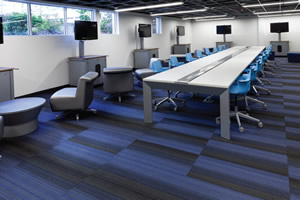
PHOTO © J&J FLOORING
“High-profile spaces, by their very
nature, typically see high foot traffic,” says
Tim Cole, vice president of marketing for
nora systems, Inc. “They tend to be used
heavily, making it difficult to close them
for extended periods of time while floors
are maintained.” In other words, being in a
prestigious location doesn’t offer the luxury
of extended time for flooring maintenance
or, for that matter, major renovations. Cole
points out, therefore, that durability and
easy maintenance are among the key factors
to consider in any flooring choice.
Cole says that the needs also include
“the floor’s maintenance requirements over
its lifetime” as well as accurately assessing
whether the flooring matches “the
performance requirements of the space,” and if the flooring works well with “a new
or existing design scheme.”
There are many ways to respond. Take
for example, the sleek epoxy flooring, with
its glossy finish, in the entrance lobby of
the Optical Science Center at Delaware State
University (DSU) in Dover. Opened in 2015,
the center is an important site for research
and collaboration, and the building is an
architectural showpiece for the campus.
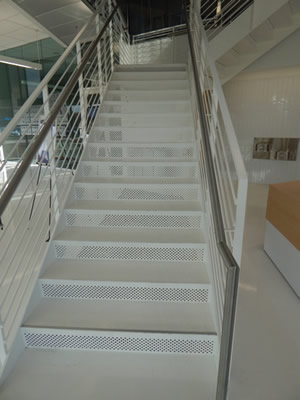
PHOTOS © SCOTT BERMAN
Just two types of flooring are specified
for the center’s laboratories, offices
and conference rooms: carpet tile and the
epoxy. The latter is a Dur-A-Flex poured
product over concrete slab that DSU’s Khalid
Zerrad, project manager for Planning
and Construction, reports is easy to clean
with the right epoxy-safe detergents and
a mop. The epoxy also provides a durable
finish to the treads and perforated risers of
a cantilevered steel staircase in the center’s
lobby. In another flooring feature, a simple
partition with river rock occupies the space
beneath the airy modern staircase.
Changes and choices continue to evolve.
In fact, “today’s higher education campuses
are unlike anything experienced by previous
generations,” says Bob Bethel, J+J Flooring
Group’s director of Business Development,
Education. He’s referring in part to the trend
of higher education “investing significant
resources to create front-of-the-house areas
that serve multiple purposes”— that is,
high-profile spaces that must serve a dynamic
range of purposes elegantly and well.

PHOTOS © SCOTT BERMAN
Bethel points out that the landscape
continues to include traditional carpet,
of course, as well as textile composite
flooring. He describes the latter solution
as a “hybrid-type flooring (that) offers the
user-friendly properties of carpet and the
durability of a hard surface, thus making it
an ideal choice for…multiple, rigorous demands
of higher education environments.”
Appearance Matters,
as Does Health
On another helpful tack, Lauri Watnee,
director of Institutional Markets for Mohawk
Group, shares conceptual ideas about
carpet and flooring for spaces that serve as
campus focal points.
Newly updated, attractive spaces “are
a tremendous selling tool” for campuses,
she says, noting the popularity of “sophisticated
design aesthetic (that tends) to follow
corporate design trends. We continue to see
the use of subtle beige and grey foundational
finishes with energizing bold accents
and patterns,” with accents, colors and patterns
also helping to provide wayfinding.
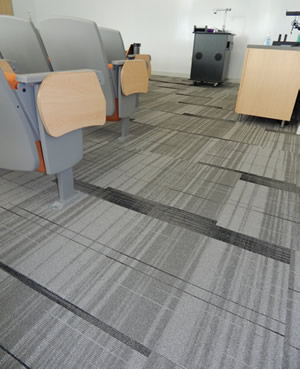
PHOTOS © SCOTT BERMAN
Watnee takes a step back to consider the
idea of prestige in such places:
“‘Prestige’ is found in how we experience a building, through its thoughtful design
and striking interior finishes, how it supports
multi-modal teaching methods, and
serves the educational and social needs of
the students and staff.”
The idea of prestige is also communicated
through “environments that support
the health and well being of those within,”
says Watnee. For example, there are “longwearing
flooring finishes with sustainable
attributes that also contribute to healthy
indoor air quality,” she explains, “There
are several product certifications that can
help identify Red List-free products and
those with low VOCs as well as their environmental
and health impacts.”
On a final note, the intensifying
preference on campuses across the nation
to specify sustainable materials does
not necessarily require an institution to
skimp on aesthetics and especially bold,
interesting color. As Cole adds about rubber
flooring, to offer one example, there
are “environmentally compatible color
pigments that are free of lead and other
heavy metals.”
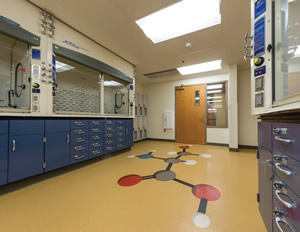
PHOTO © NORA SYSTEMS, INC.
All told, there is much to consider when
selecting carpet and flooring systems
with elegant looks and practical purposes.
Indeed, finding the right product does
much to underscore the sophistication of
an interior design or raise the design bar of
a space — all while meeting the pressing
demands of that space today and potentially,
for years ahead.
This article originally appeared in the issue of .